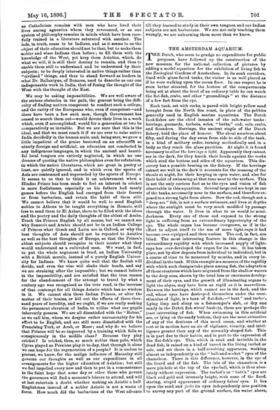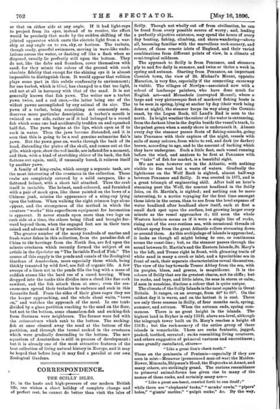THE AMSTERDAM AQUARIUM.
THE Dutch, who seem to grudge no expenditure for public purposes, have followed up the construction of the new museum for the national collection of pictures by adding a model aquarium for the exhibition of living fish to the Zoological Gardens of Amsterdam. In its sunk corridors, lined with glass-faced tanks, the visitor is as well placed as if he were walking upon the ocean floor. In one respect he is even better situated, for the bottom of the compartments being set at about the level of an ordinary table he can watch the flat-fish, crabs, and other " groundlings" at the distance of a few feet from the eye.
Each tank, set with rocks, is paved with bright yellow sand brought from the North Sea coast, in place of the pebbles generally used in English marine aquariums The Dutch food-fishes are the chief inmates of the salt-water tanks : herrings, guruards, turbots, soles, " butts," cod, eels, crabs, and flounders. Herrings, the ancient staple of the Dutch fishery, hold the place of honour. The shoal numbers about fifty, and during the day swim from side to side of the tank, in a kind of military order, turning methodically and in a body as they reach the glass partition. At night it is found necessary to allow the herrings a light. Apparently they cannot see in the dark, for they knock their heads against the rocks which stud the bottom and sides of the aquarium. This dis- covery has a possible bearing on the fishery. If the herrings cannot see well in the dark it accounts for the massing of the shoals at night, for their keeping in open water, and also for their habit of swimming at that time near to the surface. This is not the only curious fact as to the eyes and vision of fish observable in this aquarium. Several large cod are kept in one of the tanks, necessarily near to the surface, and therefore ex- posed to a strong light from above. Now the cod, though not a " deep-sea " fish, is not a surface swimmer, and lives at depths where the sunlight must be very much modified by passage through the water. It lives in what to us would be semi- darkness. Every one of these cod exposed to the strong light is suffering from an extraordinary hypertrophy of the eye. The whole organ has become overgrown, as if in the effort to adjust itself to the use of more light-rays it had become over-equipped and then useless. The cod, in fact, are blind. The most interesting feature in this change is the extraordinary rapidity with which increased supply of light- rays has over-developed the organ for its use. It has taken place, not by slow degrees from individual to individual, but in a course of time to be measured by months, and in every in- dividual in the tank. If this example is a measure of the rapidity with which such changes take place among fish, the adaptation of those creatures which have migrated from the shallow waters to the deep seas, shown by the total loss or enormous develop- ment of their eyes, and the growth of illuminating organs to light the abyss, may have been as rapid as it is marvellous. Between the herrings, which cannot see in the dark, and the cod, whose eyes have destroyed themselves under the over- stimulus of light, is a tank of flat-fish,—" butt " and turbo'. Lying limp and slimy on a fishmonger's slab, or dry and sandy in the Dutch fish-wives' baskets, these are perhaps the least interesting of fish. When swimming in this artificial sea, or lying on the sandy bottom, they are the most attractive of any of the denizens of this mock ocean, and whether at rest or in motion have an air of vigilance, vivacity, and intel- ligence greater than any of the normally shaped fish. This is in part due to their habits, and in part to the expression of the flat-fish's eye. This, which is sunk and invisible in the dead fish, is raised on a kind of turret in the living turbot or sole, and set there in a half-revolving apparatus, working almost as independently as the " ball-and-socket " eyes of the chameleon. There is this difference, however, in the eye of the lizard and of the fish. The iris of the chameleon is a mere pin-hole at the top of the eye-ball, which is thus abso- lutely without expression. The turbot's or " butt's " eyes are black and gold and intensely bright, with none of the fixed, staring, stupid appearance of ordinary fishes' eyes. It lies upon the sand and jerks its eyes independently into position to survey any part of the ground surface, the water above, or that on either side at any angle. If it had light-rays to project from its eyes, instead of to receive, the effect would be precisely that made by the sudden shifting of the jointed apparatus which casts the electric light from a war- ship at any angle on to sea, sky, or horizon. The turbots, though ready, graceful swimmers, moving in wave-like undu- lations across the water, or dashing off like a flash when so disposed, usually lie perfectly still upon the bottom. They do not, like the dabs and flounders, cover themselves with sand, for they mimic the colour of the ground with such absolute fidelity that except for the shining eye it is almost impossible to distinguish them. It would appear that volition plays some part in this subtle conformity to environment; for one turbot, which is blind, has changed to a tint too light, and not at all in harmony with that of the sand. It is not generally known that fish yawn. The writer saw a turbot yawn twice, and a cod once,—the latter being one of the widest yawns accomplished by any animal of its size. The yawn of a turbot, being something not commonly seen, deserves more particular description. A turbot's month is twisted on one side, rather as if it had belonged to a round fish which some one had accidentally trodden on and squashed half-flat. The yawn begins at the lips, which open as if to suck in water. Then the jaws become distended, and it is seen that this is going to be a real genuine submarine fish's yawn. But the yawn goes on, works through the back of its head, distending the plates of the skull, and comes out at the gills, which open, show the red inside, are inflated for a moment, and then, with a kind of stretching shiver of its back, the fish flattens out again, until, if unusually bored, it relieves itself by another yawn.
A family of king-crabs, which occupy a separate tank, are the most interesting of the crastacea in the collection. These crabs are completely covered by a solid carapace, like a flattened helmet, with a short tail attached. Thus the crab itself is invisible. The helmet, sand-coloured, and furnished with a pair of mock eyes, like those painted on the bows of a Chinese junk, mimics the appearance of a sting-ray lying upon the bottom. When walking the eight crimson legs alone appear, and the strangeness of the method in which the creature "works" this superfluous equipment for locomotion is apparent. It never stands upon more than two legs on each side at a time, the others being lifted and brought for- ward beyond them, when the engaged feet are in their turn raised and advanced as if by machinery.
The greater number of the many hundreds of marine and fresh-water fishes in this collection, from the paradise-fish of China to the herrings from the North Sea, are fed upon the minute crustacea which recently formed the subject of an article in the Spectator on " The Invisible Food of Fish." The source of this supply is the ponds and canals of the Zoological Gardens of Amsterdam, more especially those which, being thickly tenanted by wild fowl, are full of organic life. A few sweeps of a linen net in the ponds fills the bag with a mass of reddish atoms like the hard roe of a cured herring. When dropped into the tanks this divides into a cloud like fine cork sawdust, and the fish attack them at once; even the sea- anemones spread their tentacles to embrace and suck in this favourite food. From the sides of their glass cages they see the keeper approaching, and the whole shoal waits, " bows on," and watches the approach of the meaL In one tank, divided by a glass partition reaching to the sand on the floor, but not to the bottom, some chameleon-fish and sucking-fish from Surinam were neighbours. The former were fed with the entonzostraca which sank to the bottom. The sucking- fish at once cleared away the sand at the bottom of the partition, and through the tunnel sucked in the crustacea which were gradually descending to the bottom. The new aquarium of Amsterdam is still in process of development ; but it is already one of the most attractive features of the best collection of living natural history in Europe, and it may be hoped that before long it may find a parallel at our own Zoological Gardens.







































 Previous page
Previous page